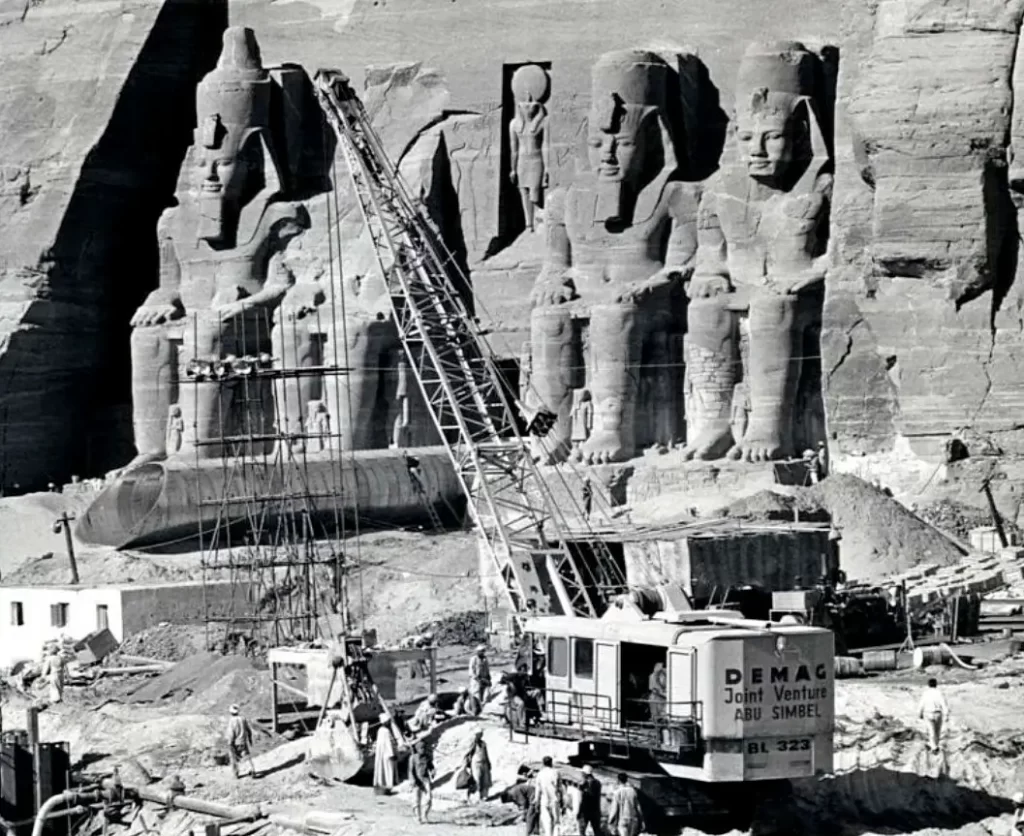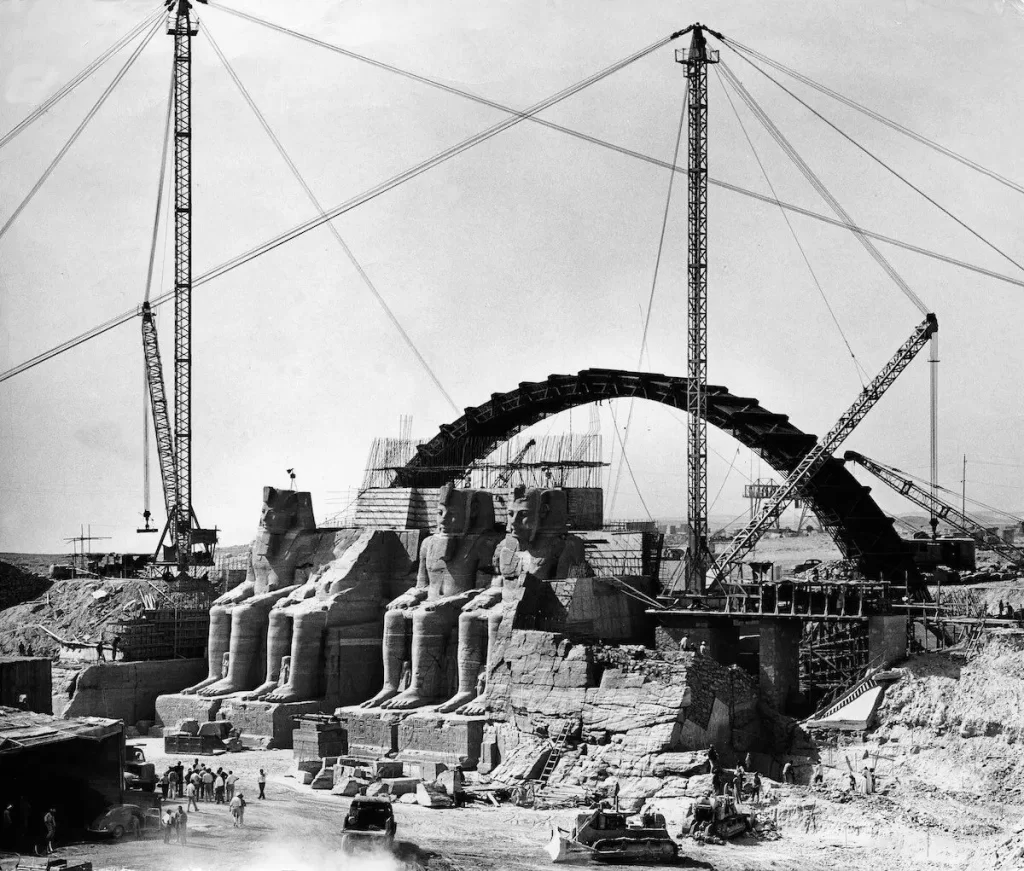Abu Simbel Egypt

Abu Simbel
Carved into a sandstone cliff in southern Egypt, far from the bustle of Cairo and the Nile’s greener banks, the temples of Abu Simbel rise like stone sentinels in the desert. Towering statues gaze eternally over the Nubian sands, declaring the power of one man: Pharaoh Ramses II.
But Abu Simbel is more than ancient architecture. It’s a UNESCO World Heritage marvel, a tale of love and ego, a beacon of divine kingship, and a symbol of modern engineering genius. Few places combine history, spirituality, art, astronomy, and international cooperation so flawlessly.
Abu Simbel isn’t just seen—it’s experienced. And once you stand in its shadow, you never forget it.
Where Is Abu Simbel Located?
Abu Simbel lies in southern Egypt, near the border with Sudan, in the region historically known as Nubia. Specifically, it’s located on the western bank of Lake Nasser, about 280 kilometers south of Aswan.
The area was once known for its gold-rich deserts and strategic military importance. Today, it is one of the most visited locations in Upper Egypt, thanks to both its ancient significance and the spectacular modern effort to save it.
Although remote, Abu Simbel is accessible by:
-
Short flights from Aswan or Cairo
-
Bus tours (though long and hot)
-
Lake Nasser cruises, which offer a scenic journey with multiple temple stops
Historical Background of Abu Simbel
Commissioned during the reign of Ramses II (c. 1279–1213 BCE), Abu Simbel was designed to celebrate his greatness and divinity—especially in the eyes of Egypt’s southern neighbors in Nubia.
It’s part of a larger tradition of temple-building during the New Kingdom, when pharaohs used monumental structures to solidify their legacy and claim spiritual status.
Construction began around 1264 BCE and likely took over 20 years to complete. It was a herculean task that involved cutting into solid mountain, aligning doorways with celestial bodies, and carving intricate scenes into interior walls.
Twin Temples of Abu Simbel
There are actually two temples at Abu Simbel:
The Great Temple of Ramses II
-
Dominated by four 20-meter statues of the pharaoh himself
-
The facade shows Ramses seated, flanked by smaller figures representing his family
-
Inside are hypostyle halls with colossal statues, wall reliefs of battle scenes (like the Battle of Kadesh), and depictions of gods such as Ra-Horakhty, Ptah, and Amun
The Small Temple of Nefertari
-
Dedicated to Queen Nefertari and the goddess Hathor
-
Features six statues (two of Nefertari, four of Ramses) each about 10 meters high
-
Exceptionally rare: Nefertari is depicted equal in size to the king—a powerful tribute to her status
These twin temples symbolize both divine power and romantic devotion, making Abu Simbel a place of grandeur and heart.
Sun Festival Phenomenon
One of Abu Simbel’s most mind-blowing features is the biannual solar alignment—known as the Abu Simbel Sun Festival.
On February 22 and October 22 every year:
-
Sunlight penetrates deep into the Great Temple’s sanctuary
-
It illuminates statues of Ramses II, Ra-Horakhty, and Amun-Ra
-
Only the statue of Ptah (god of the underworld) remains in shadow
These dates are believed to mark Ramses’ birthday and coronation day, aligning architecture with celestial precision. Even after relocation (more on that soon), the effect continues with minimal deviation—a testament to ancient ingenuity and modern engineering.
UNESCO and the Relocation of Abu Simbel

Abu Simbel
In the 1960s, Abu Simbel faced total submersion due to the creation of Lake Nasser, following the construction of the Aswan High Dam. This crisis sparked a historic global effort.
Between 1964 and 1968, an international team led by UNESCO:
-
Dismantled the temples into over 1,000 blocks
-
Relocated them to higher ground, 65 meters up and 200 meters back
-
Reconstructed them in exact orientation with the sun alignment preserved
This feat is still considered one of the greatest archaeological rescue operations in history. It also marked a turning point in global cultural preservation, leading to more awareness and action for heritage sites worldwide.
The Temple of Nefertari
Among all the temples of ancient Egypt, only one stands dedicated to a queen: Nefertari’s Temple at Abu Simbel.
Here, Ramses did something extraordinary. He made his queen equal in height, a visual rarity in a culture where kings dwarfed everyone—even gods. This equality was no accident. It reflected:
-
Nefertari’s political influence
-
Her role in religious rituals
-
Their deep personal bond
Inside, the walls are covered with graceful images of Nefertari presenting offerings, participating in ceremonies, and standing beside Hathor—goddess of beauty, music, and love. It is a monument of affection carved into stone.
Art and Inscriptions Inside Abu Simbel
Step inside Abu Simbel, and you’re instantly transported into a world where walls speak, and gods walk beside kings.
The interior of the Great Temple is nothing short of awe-inspiring:
-
Massive statues of Ramses line the central hall, each standing over 10 meters tall
-
Reliefs show him smiting enemies, offering gifts to deities, and performing sacred rituals
-
Hieroglyphic inscriptions praise his divine lineage, his might, and his eternal connection with gods like Amun-Ra and Ptah
This was more than propaganda. It was spiritual theater. Every chisel stroke was designed to convey power, divinity, and eternity.
The colors, though faded, still peek through—reds, blues, and golds that once lit up the chambers like stained glass. The combination of architecture and storytelling makes this temple one of the finest examples of ancient narrative art in the world.
The Battle of Kadesh Relief
Perhaps the most famous panel in the Great Temple is the Battle of Kadesh relief. It depicts Ramses II’s military clash with the Hittites, believed to have occurred around 1274 BCE.
In the relief:
-
Ramses is shown charging alone into enemy ranks, bow drawn, in a chariot of fire
-
Hittite soldiers flee in terror, while Ramses rescues his surrounded troops
It’s one of history’s earliest recorded battles, and this portrayal is arguably the world’s first propaganda campaign.
Though the battle likely ended in a draw, Ramses had it immortalized as a triumph, making sure the gods and his people would remember only one victor—him.
Abu Simbel and Egyptian-Nubian Relations
Abu Simbel was no random choice for temple construction. It was a political message, boldly placed at Egypt’s southern frontier.
The area had long been home to Nubian tribes, some of whom resisted Egyptian control. By building colossal temples in this region:
-
Ramses asserted Egyptian dominance
-
Symbolically “watched over” the south
-
Integrated Nubia into Egyptian religious and cultural orbit
It was both a warning and an invitation—resist and be crushed, or join and be embraced by the divine king.
Archaeological Discoveries and Research

Abu Simbel
Even though Abu Simbel was “discovered” by Swiss explorer Johann Ludwig Burckhardt in 1813 and fully excavated by Giovanni Belzoni in 1817, the site continues to yield surprises.
New research and technologies (like ground-penetrating radar) have revealed:
-
Hidden shafts and chambers beneath the plateau
-
Traces of worker villages and quarry sites
-
Inscriptions that revise our understanding of Ramses’ theology
Every generation of Egyptologists builds on the last, peeling back more layers of this enigmatic site.
Mysteries and Myths of Abu Simbel
Despite centuries of study, Abu Simbel still holds secrets:
-
One statue of Ramses lies toppled—its exact cause still debated
-
Why did Ramses build two temples so far south instead of nearer to Thebes?
-
How did they align the temple so perfectly with the sun without modern instruments?
And then there are astronomical theories, suggesting deeper alignments with constellations or even lost rituals performed only during the solstices.
In every corner, Abu Simbel whispers: “There is more.”
Visiting Abu Simbel Today
Want to stand in the shadow of giants? You’re not alone. Over 500,000 tourists visit Abu Simbel annually—especially during the Sun Festival.
Ways to visit:
-
Fly from Aswan (45-minute flight)
-
Bus or van tours (3–4 hours each way, best done early morning)
-
Lake Nasser cruise, docking right near the temples
Tips:
-
Arrive at sunrise for magical lighting and fewer crowds
-
Bring water and sun protection—the desert is unforgiving
-
Photography is allowed outside, but inside photos may be restricted or require permits
Best Time to Visit Abu Simbel
The ideal times to visit are:
-
October to April, when temperatures are cooler
-
February 22 & October 22, to witness the Sun Festival alignment
During festival days, the site comes alive with:
-
Traditional Nubian dances
-
Music performances
-
Light shows and guided storytelling
-
A sense of shared awe
It’s part spiritual celebration, part tourism spectacle, and 100% unforgettable.
FAQs
Who built Abu Simbel?
Pharaoh Ramses II built both temples during the 13th century BCE to commemorate his reign and assert his divinity.
Why was Abu Simbel relocated?
To save it from submersion due to the Aswan High Dam project in the 1960s. It was moved piece by piece by UNESCO over four years.
What is the Sun Festival at Abu Simbel?
It’s a biannual solar event when sunlight penetrates the temple’s sanctuary and illuminates specific statues. It occurs on February 22 and October 22.
How long did construction take?
Historians estimate it took around 20 years to complete both temples.
Can tourists enter the temples?
Yes! Visitors can explore both temples, but photography may be limited inside.
What’s the best way to visit Abu Simbel?
A short flight from Aswan is the most convenient. Cruises and road trips are also possible for more immersive experiences.
Conclusion: Abu Simbel — The Stone Symphony of Eternity
Abu Simbel isn’t just another temple. It’s a story in stone, a symphony carved by thousands of hands under the watchful eyes of the gods and their chosen king.
It’s where love (Nefertari), power (Ramses II), and time (the sun itself) converge to whisper one truth: what is truly great will never be buried—only reborn.
In every statue, every shadow, and every shaft of light, Abu Simbel asks you to stop, look, and remember: this was once the edge of the known world. And at that edge, the Egyptians etched their legacy in stone.







Good https://shorturl.at/2breu
Very good https://lc.cx/xjXBQT
Very good https://lc.cx/xjXBQT
Very good https://t.ly/tndaA
Awesome https://is.gd/N1ikS2
Very good https://is.gd/N1ikS2
Awesome https://is.gd/N1ikS2
Самые популярные материалы для зубных мостов.
Сколько стоит мост на 4 зуба [url=http://www.koronki-blog.ru/mostovidnoe-protezirovanie/]http://www.koronki-blog.ru/mostovidnoe-protezirovanie/[/url] .
Что нужно знать о несъемном протезировании на 4 имплантах.
Имплантация all on 4 стоимость [url=https://www.ggpatl.by/allon4-implantaciya]https://www.ggpatl.by/allon4-implantaciya[/url] .
Лучшие методы установки мостовидных несъемных протезов.
Мостовидный протез на верхнюю челюсть [url=https://www.belfamilydent.ru/services/mostovidnoe-protezirovanie]https://www.belfamilydent.ru/services/mostovidnoe-protezirovanie[/url] .
Economy car rental with no hidden fees
best car hire paphos [url=https://rent-car-airport.com/]https://rent-car-airport.com/[/url] .
Hi!
Trading binary options has never been easier, thanks to our cutting-edge platform and advanced tools. Invest in the stock market, commodities, and forex without any prior experience, and start earning profits today.
Earn every minute without limit of $100, $500, $1,000, with a minimum bet of $1.
Instant withdrawal!!!
Bonus code: OLYMPOLYMP
From $50 +30% to deposit!
+ Demo account!
+ Free Signals!
WARNING! If you are trying to access the site from the following countries, you need to enable VPN which does not apply to the following countries!
Australia, Canada, USA, Japan, UK, EU (all countries), Israel, Russia, Iran, Iraq, Korea, Central African Republic, Congo, Cote d’Ivoire, Eritrea, Ethiopia, Lebanon, Liberia, Libya, Mali, Mauritius, Myanmar, New Zealand, Saint Vincent and the Grenadines, Somalia, Sudan, Syria, Vanuatu, Yemen, Zimbabwe.
Sign up and start earning from the first minute!
https://trkmad.com/101773
Элитные коллекции мебели для истинных ценителей.
Мебель премиум [url=http://www.byfurniture.by/]http://www.byfurniture.by/[/url] .
Certified Roofing Contractors in Wilmington City
Dwelling by the shoreline has many advantages: briny air, stunning views and the distinct sound of breakers pounding along the coast are among them. However, being there also brings special issues: gusts, showers and the ever-present salt-filled breeze can harm roofing surfaces causing leaks, liquid infiltration and potentially fungus growth beneath shingles, thus necessitating hiring a specialist roof contractor in Wilmington NC to resolve these issues effectively. That is why possessing reach to reliable roofing professionals in Wilmington North Carolina is crucial!
Roof contractors licensed with the State can assess possible problems and take precautionary actions to keep roofing systems in good order – this could save expenses in corrections while providing a safer workspace or living space for employees or inhabitants.
These companies specialize in residential and business roof work such as metallic roofing installs, spray foam roofing projects, thermal roof coating projects, roof covering repair solutions, complete replacements of both house and commercial rooftops and maintenance tasks. Furthermore, they can handle installations for residential associations to meet standards.
Roof contractors certified in Wilmington must carry liability and bond coverage when performing roof work at residences and businesses, to protect property owners from possible damages that may occur during a project and make certain their roofing system is repaired or renewed by qualified specialists. Additionally, it helps the homeowner validate whether their preferred licensed roofing expert has the knowledge and ability to offer premium work.
[url=https://portcityexteriors.com/roofing-wilmington-nc/]Asphalt roofing solutions by Castle Hayne NC[/url]
[url=https://techbd24.xyz/five-tips-for-buying-medicare-supplement-insurance/#comment-48703]Increasing Roof Lifespan with Safeguarding Layers[/url] 167b522
All engaged couples envision their wedding in the Pacific Northwest to be unforgettable. And when it comes to freezing those moments in time, frames are what truly bring everything back.
That’s where a trusted photography name comes in. Someone who’s not only detail-oriented, but also has the kind of credibility that sets them apart. When looking at real reviews, you’ll find that great service and emotional storytelling go hand in hand.
Your formal pictures should feel as comfortable as your love. Whether it’s just the two of you or a full wedding party, a pro will create a calm environment without it ever feeling forced.
In our rainy paradise, that kind of ease matters. Light can shift, rain can fall, plans change—but your photographer shouldn’t miss a beat. With a deep understanding of gentle adjustments, your comfort will always be part of the plan—no matter what shoes you’re wearing or how long the ceremony runs.
One of the most overlooked things when choosing a photographer is how they interact with attendees, vendors, and especially you. A true pro brings uplifting attitude from start to finish. You’ll see it in their process, and it shines through in their turnaround time. Feeling uncertain shouldn’t be part of your wedding story.
So when you’re narrowing down your options for your Seattle wedding, keep your eyes on more than just the dollar amount. Think about who you want to trust with the timing. Your highly reviewed visual pro won’t just deliver images—they’ll give you stories you’ll treasure forever.
[url=https://nickhanyokimaging.com/contact-nick-hanyok/]candid wedding moments[/url]
[url=https://dailynotesjournal.com/what-is-now-gg/#comment-16985]Preserving Romance PNW Marriage Snapshots The Path of a Wedding Lensman in Emerald City[/url] 9bce84c
Converting your home deal into a money sale and flipping residences for profit can be a very rewarding endeavor in the property industry, if you meticulously organize and arrange. Start by precisely assessing your property’s marketplace value through licensed evaluations, relative marketplace comparisons, or digital appraisal resources. Proper costing is crucial to prevent financial shortfalls or prolonged offering times. Engaging a expert real estate professional can offer useful guidance to establish a fair and accurate asking price in line with current marketplace trends.
Before marketing your house for a cash sale, focus on performing essential improvements and enhancements, especially in key spaces like the cooking area and bathrooms, which can substantially boost your home’s price and investor attractiveness. Keeping your home clean and orderly is important to drawing possible investors fast. Additionally, staging your property by organizing, arranging furnishings carefully, and incorporating attractive decorations can generate an inviting ambiance that increases investor attraction. Engaging a professional property stager can further optimize your home’s appearance.
For those aiming to revolve houses for gain, getting the appropriate funding is vital. Evaluate options such as standard lender credits, alternative loans, or personal loans, and choose one that aligns with your economic condition and undertaking demands. Verify you have a solid return plan in order. Partnering with the proper experts, like housing agents, builders, inspectors, and law experts, is crucial for a effective flipping project. These experts can help in discovering the ideal home, handling renovations and upgrades, assessing estate status, and managing law-related matters, guaranteeing a efficient and profitable revolving process. For more insights and references on this area, feel free to explore my top resource.
Whenever you decide you’d like to know more about this one matter have a look at my webpage:
[url=https://www.stephburtcashoffers.com/we-buy-houses-in-stockbridge-georgia/][color=#000_url]offering home with unpermitted renovations in Atlanta Georgia and South Fulton Georgia 30331[/color][/url]
[url=http://daphnefortreasurer.com/back-to-school/]Detect a Profitable Deal in Wholesaling[/url] c9bce84
Home appliance repair: tips for everyone, will be helpful have these recommendations at hand.
how to fix a leaky washer [url=https://www.technirepair.com/washer-repair-tips-how-to-fix-common-washing-machine-issues]https://www.technirepair.com/washer-repair-tips-how-to-fix-common-washing-machine-issues[/url] .
Cool partnership https://shorturl.fm/a0B2m
Selling your home for money and flipping residences for gain can be an superb approach to generate profit in the property industry, but it demands detailed organization and arrangement. Begin by precisely determining your home’s sector price, which you can attain through certified evaluations, contrasts with comparable properties, or digital assessment instruments. Accurate valuing is essential to prevent monetary deficits or prolonged selling periods. Consulting a real estate broker can provide important insights to help you set a reasonable and accurate value matching current marketplace conditions.
Before marketing your home for cash, focus on conducting critical improvements and upgrades, notably in important spaces like the cooking area and bathrooms, which can greatly boost your house’s price and desirability. Making sure that your estate is well-maintained and orderly is critical to luring prospective investors promptly. Additionally, presenting your home by organizing, placing fixtures strategically, and incorporating elegant decor can generate an cozy ambiance that enhances buyer interest. Consulting a certified house arranger can additionally improve your house’s appearance.
For those seeking to revolve houses for profit, obtaining the appropriate investment is crucial. Choices such as conventional lender funds, private funds, and individual credits are obtainable, and it’s important to select one that aligns with your financial situation and venture needs. Confirm you have a robust repayment plan in place. Partnering with the proper professionals, such as real estate professionals, renovators, inspectors, and law experts, is vital for a effective house flipping project. These professionals can aid in finding the right home, handling renovations, assessing property status, and handling contractual issues, ensuring a efficient and profitable revolving procedure. For additional insights and references on this area, please visit my top resource.
Should you like to be taught more about your content click on my excellent web address:
[url=https://www.stephburtcashoffers.com/we-buy-houses-in-east-point-georgia/][color=#000_url]our company provide funds for your own house in one week around Atlanta Georgia and South Fulton Georgia 30213[/color][/url]
[url=https://lendingflash.com/2023/05/10/hello-world/#comment-54948]Presenting their Renovated Home available for sale[/url] 5db50a8
https://shorturl.fm/m8ueY
https://shorturl.fm/6539m
https://shorturl.fm/6539m
https://shorturl.fm/XIZGD
https://shorturl.fm/oYjg5
Как достичь высоких позиций в поисковых системах, для достижения максимального эффекта.
GSA ссылки [url=kwork.ru/links/41629912/seo-pushka-dlya-sayta-mnogourovnevaya-piramida-ssylok-pod-klyuch]kwork.ru/links/41629912/seo-pushka-dlya-sayta-mnogourovnevaya-piramida-ssylok-pod-klyuch[/url] .
Advanced Approaches to Construction, that will help you.
eco-friendly construction materials [url=rapidlybuild.com/green-building-materials-sustainable-choices-for-construction]rapidlybuild.com/green-building-materials-sustainable-choices-for-construction[/url] .
Analyzing the Features.
are electric cars cheaper to run? [url=http://livelycars.com/electric-vs-gasoline-cars-pros-and-cons/]http://livelycars.com/electric-vs-gasoline-cars-pros-and-cons/[/url] .
How to improve your skills, a key aspect.
benefits of forming an LLC [url=http://www.timetobuiseness.com/choosing-the-right-business-structure-llc-corporation-or-sole-proprietorship]http://www.timetobuiseness.com/choosing-the-right-business-structure-llc-corporation-or-sole-proprietorship[/url] .